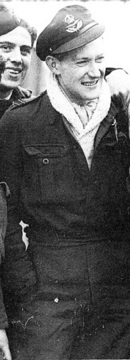
S32455
KLENNER, George Frederick
| Service Number: | 429813 |
|---|---|
| Enlisted: | 12 September 1942, Adelaide |
| Last Rank: | Flying Officer |
| Last Unit: | Operational Training Units (RAAF) |
| Born: | Torrensville, South Australia, Australia , 2 July 1923 |
| Home Town: | Torrensville, South Australia |
| Schooling: | Thebarton and Adelaide High Schools, South Australia |
| Occupation: | Junior Clerk at General Motors Holdens. |
| Died: | Natural Causes, Adelaide, South Australia, 12 August 1993, aged 70 years |
| Cemetery: |
Centennial Park Cemetery, South Australia Native, Shrub Area F, Position 122 |
| Memorials: | South Australian Garden of Remembrance |
World War 2 Service
| 12 Sep 1942: | Involvement Flying Officer, 429813 | |
|---|---|---|
| 12 Sep 1942: | Enlisted Adelaide | |
| 12 Sep 1942: | Enlisted Royal Australian Air Force, Flying Officer, 429813, Operational Training Units (RAAF), Adelaide, SA | |
| 5 Sep 1945: | Discharged | |
| Date unknown: | Honoured Distinguished Flying Cross |
Help us honour George Frederick Klenner's service by contributing information, stories, and images so that they can be preserved for future generations.
Add my storyBiography contributed by Michael Stewart
Flying Officer George Frederick Klenner DFC S/N 429813 was the son of Arthur Klenner who won a MM with the 10th Battallion in France during WW1.
George was raised in Torrensville, a suburb just west of the Adelaide CBD. he attended local schools and prior to his enlistment was a junior clerk at General Motors Holden at Woodville.
George enlisted on 12th September 1942 aged 18 years and two months. His Initial Training was conducted at Victor Harbour then he was off to Western Australia to Cunderdin and Geraldton for Elementary and Service Flying Training. Once this stage of his training was completed he returend to Adelaide prior to departing for England on 4th August 1943.
Once in England he went through the various flying courses working up to becoming an operational pilot. the aircraft flown included Ansons, Wellingtons, Stirlings and Lancasters.
The training was not without danger, George messed up a landing approach in a Stirling four engined bomber. Instead of executing a 'go around' he tried to land the plane which resulted in it running through a hedge at the end of the runway and over a ditch which snapped off the undrcarriage and tore off a wing. The seven man crew crawled out of the wreck with minor injuries but the aircraft was a write off and George received a red inked endorsement in his log book for showing 'poor judgement'. More about this a bit later in the narrative.
Training completed they became an operational crew joining 218 Squadron RAF at Methwold flying the famous Lancaster bomber.
There were two George's in the crew, Klenner and George Bell who was the wireless operator so to prevent confusion Klenner was now referred to as 'Dig', short for 'Digger'. Dig and his crew began their operational tour in October 1944 completing 40 trips over enemy territory. Their last operation was to Essen on 11th March 1945. During the tour Dig was awarded the DFC for pressing on to bomb the target after he had to shut down an engine which made them slower and lower and more vulnerable to attack and danger.
Dig's Bomb Aimer was Miles Trip who became a successful author post war and wrote of the crews experiences in a book titled "The Eighth Passenger'.
The book deals with all the raw emotions of operational flying including fear and how seven men from various backgrounds with different personalities and temperaments came together and managed to work as a team to stay alive in the most dangerous of environments. I rate the book the equal of Guy Gibsons 'Enemy Coast Ahead' and Jack Currie's 'Lancaster Target'.
Dig returend to Australia in July 1945 and discharged from the RAAF in September 1945. He returned to his job at General Motors Holden.
Fast forward to 1990 and I'm living in Adelaide and have just read 'The Eighth Passenger'. The author has told me that George is still living in Adelaide so out of curiosity a quick look at the Adelaide phone directory tells me there is a G F Klenner living at 31 Pine Ave Glenelg North. To call or not to call? What sort of a reaction was i going to get? Was Dig damaged by war, how was his health? I just wanted to tell him how much I enjoyed the book and I suppose to say a thank you for his bravery and efforts all those years ago.
Eventually i took the plunge and Dig could not have been nicer. "Yes, since the book came out im getting calls all the time and people even stop to say 'hello' and talk about the book when im out in the front garden". I think he was really happy and comfortable in the recognition he was getting and rightly so I say.
I went to his house and met Dig, slightly stooped and hard of hearing as most air crew who flew in those days ended up. He proudly gave me his DFC medal to hold and showed me his log bok with the red ink endorsement still in it re the pranged Stirling. Dig was still miffed about it, "should have got a medal, the aircraft was war weary and about to go to the scrap yard anyway".
A lovely bloke and great company. Sadly he passed in 1993 aged 70.











